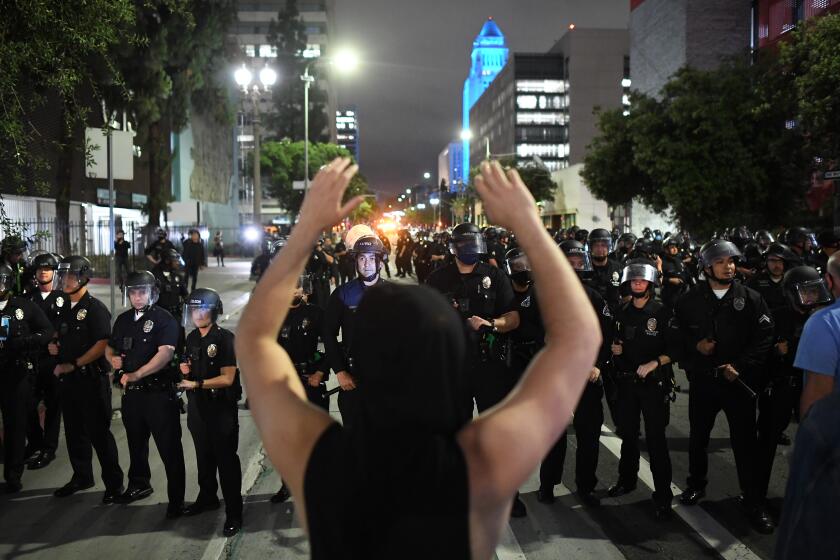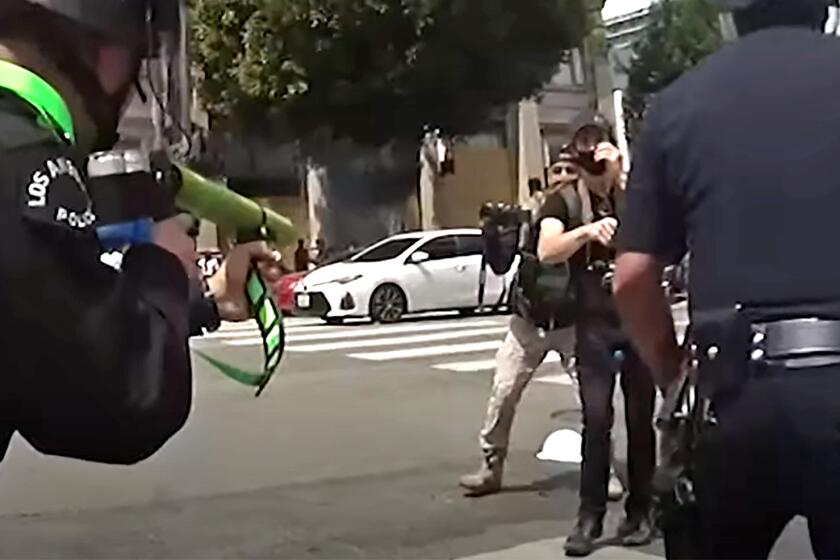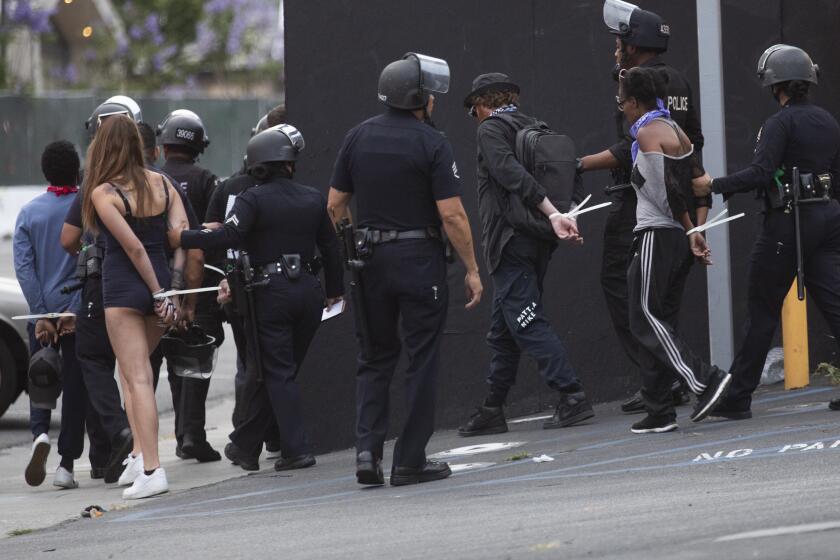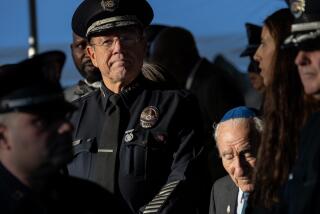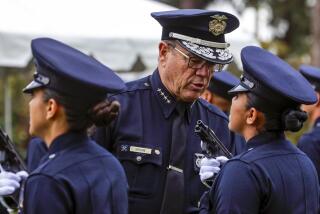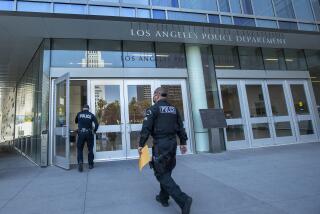Two more reports find fault in LAPD’s handling of summer protests
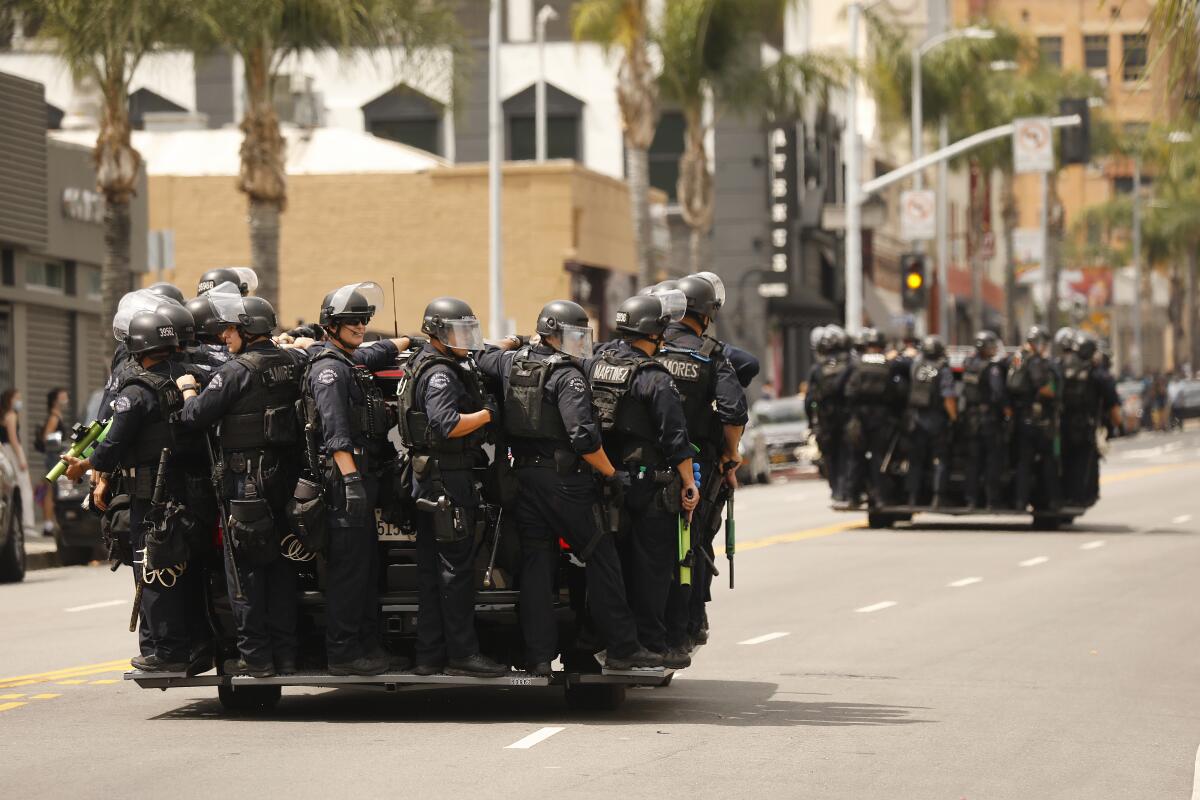
Two more reviews have found glaring problems with the Los Angeles Police Department’s handling of last summer’s mass protests against police brutality, with both concluding that poor planning, inadequate training and inconsistent leadership contributed to disorder in the streets.
The reports, both released Friday, also provide new estimates for damage and losses stemming from the unrest, including an estimated $167 million in losses sustained by private property and business owners and nearly 570,000 doses of amphetamines, painkillers and other powerful drugs stolen or missing from burglarized pharmacies.
In its internal report, the LAPD acknowledged inadequate “command and control” training for officers, failures by supervisors to properly communicate strategies to officers on the ground and an outdated approach to protests that did not allow the department to react to and control multiple large demonstrations at once.
The department found that leadership decisions that focused resources and planning on the downtown area ahead of large clashes that instead erupted in the Fairfax district proved an “error in judgment” that led to confusion in command posts and commanders from different areas descending on the same scenes to give contradictory orders — further complicating “an already chaotic situation.”
The report blamed protesters for instigating violence and injuring officers and said the department had attempted to facilitate the protests until serious threats from members of the crowds and other criminals intent on taking advantage of the disorder made that impossible. In a letter to the civilian Police Commission that accompanied the report, Chief Michel Moore acknowledged “missteps and shortfalls in communication and command and control, especially from senior staff in the field” but said the vast majority of officers “performed admirably” in the face of threats and should be commended.
Individual allegations of officer misconduct and excessive force were not addressed in the main LAPD report, but instead broken out into its own supplemental report to the commission. That report found that LAPD investigators have rejected as unfounded or unsupported by evidence most of the complaints against officers that they have assessed, while other cases remain under review.
Of 73 allegations that officers used nondeadly force inappropriately, 33 have been resolved — without officers facing punishment in a single one. In addition, five cases involving alleged use of deadly force, including officers shooting people with projectiles, remain under review, though the department’s use-of-force panel has concluded the officers acted appropriately in several of them.
In a second report produced on behalf of the Police Commission, officials with the National Police Foundation wrote that the city and the LAPD thought they were prepared for such large-scale protests but were not and that the “extent of the protests and the level of violence associated with them overwhelmed the LAPD and led to resources being deployed without clear missions or assignments.”
The foundation concluded the LAPD’s policies for crowd management were inadequate, that its training of officers for such situations was outdated and that communication between Moore and other top commanders was inconsistent — making it harder to identify a “cogent operating philosophy.”
It found that the city “lacked a well-coordinated city-wide political, policy, communications, and law enforcement response,” while the LAPD had no single policy for responding to such “large-scale, fluid, city-wide civil unrest.”
The two reports follow another produced last month for the City Council that found that a lack of preparation, poor training and a “chaos of command” had led to some of the same crowd-control mistakes the LAPD has been reprimanded for in the past, including in court cases that cost the city millions.
The council report spurred members to demand more information from the LAPD on training, the use of projectile munitions and other rules for engaging with protesters, and drew promises of lasting changes from them and Mayor Eric Garcetti.
The LAPD mishandled the unrest that erupted after the death of George Floyd, according to a new report commissioned by the City Council.
The two new reports are set to be discussed by police officials at the Police Commission’s virtual meeting Tuesday. Garcetti has said all three reports would inform the ongoing City Hall discussions about next steps, and on Friday said the city “must reimagine public safety in Los Angeles by reflecting on our actions, and using the lessons learned to shape our future.”
Activists have dismissed the reports as inherently biased and said the only appropriate steps are to fire Moore and defund the LAPD in favor of more social service programs and mental health providers in under-resourced communities.
The reports are part of a much larger wave of scrutiny that also includes multiple lawsuits against the city for its protest response, and come nearly a year after high-profile police killings of Black people in other cities — including George Floyd in Minneapolis and Breonna Taylor in Louisville, Ky. — sparked protests across the U.S.
In L.A., smaller protests grew for days before exploding downtown and in the Fairfax district on May 30, when large crowds clashed with LAPD officers in riot gear. That night and days after, the LAPD made thousands of arrests, many involving protesters who missed or ignored dispersal orders or were caught outside during nightly curfews. More than 100 officers reported being injured, and more than 50 protesters claimed they were injured by police.
For the LAPD, it will be another period of forced change brought on by investigations and several lawsuits after the summer protests.
The National Guard was called in to help restore order, and the chaos made way to days of peaceful protests. A later police review found that a vast majority of the summer’s protests remained peaceful.
In its report Friday, the LAPD said that the COVID-19 pandemic and new tactics by protesters “to thwart law enforcement’s efforts to facilitate the protest or enforce the law” made controlling the demonstrations that spiraled out of control more difficult.
They said that while “narratives” put forth by protesters on social media “created the impression that the violent and destructive elements could have been easily identified, isolated and extracted from the otherwise peaceful crowd,” the “truth is not nearly so simple.”
The department said past training “related to static, short-term, pre-planned, single location demonstrations” like those the city has seen over the last 30 years “was not helpful when spontaneous and leaderless groups emerged throughout the City and violence broke out from within the crowd.”
The department said it has already retrained 4,000 officers on crowd control and implemented new policies for field arrests and processing of arrestees, but that the city will have to “prioritize and fund” additional efforts to improve.
LAPD used violence to quell protests over police brutality, using batons and ‘less lethal’ bullets in ways that probably violated protocols.
The National Police Foundation’s review was requested by the Police Commission in July and paid for with $350,000 from the Los Angeles Police Foundation.
Jim Burch, the foundation’s president, said he was not authorized by the city to discuss the report Friday. The report — titled “A Crisis of Trust” — said neither the commission nor the LAPD influenced its findings, which activists had questioned at a virtual listening event in February.
The foundation found that the city and LAPD were caught flat-footed, even as protests over Floyd’s killing grew across the country, because they thought anger over an incident in another city would not escalate into violence in L.A.
Once the protests were underway, the foundation found that LAPD commanders and elected leaders “added to the confusion regarding decision-making authorities, roles, and responsibilities” at the incident command center, and that the LAPD “did not effectively leverage intelligence” from social media that could have “enhanced situational awareness” of officers in the field.
The foundation also found that officers, some of whom were injured during the unrest, and their families had experienced “stress and trauma” as a result of the events, which was further exacerbated by the impacts on the department from the COVID-19 pandemic. It said officers perceived a lack of support from department and city leaders, and that officer morale was described “almost universally as ‘at an all-time low.’”
The foundation recommended the LAPD develop better plans for large, disparate protests by utilizing national best practices, develop special units to engage with protest organizers before, during and after events, and improve protocols for command-level communications.
It recommended the LAPD seek out community input to shape future approaches to demonstrations but also develop a better communications strategy so that demonstrators cannot “control the narrative and overwhelm LAPD on the information front.”
More to Read
Start your day right
Sign up for Essential California for news, features and recommendations from the L.A. Times and beyond in your inbox six days a week.
You may occasionally receive promotional content from the Los Angeles Times.
